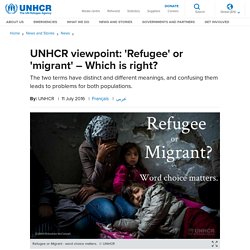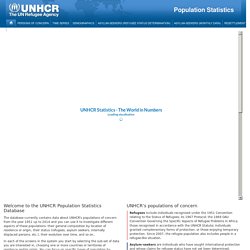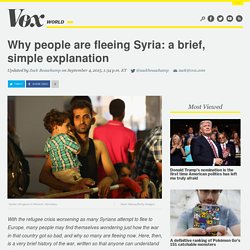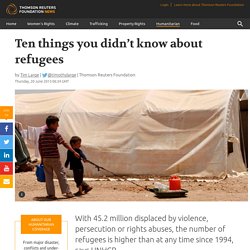

Over under sideways down. Refugee. The Side Eye: Aussie Aussie Aussie, Shame Shame Shame. Searching for Syria. Global Trends 2015. Refugee or migrant. Refugee or Migrant - word choice matters. © UNHCR GENEVA, July 11 (UNHCR) – With more than 65 million people forcibly displaced globally and boat crossings of the Mediterranean still regularly in the headlines, the terms 'refugee' and 'migrant' are frequently used interchangeably in media and public discourse.

But is there a difference between the two, and does it matter? Yes, there is a difference, and it does matter. The two terms have distinct and different meanings, and confusing them leads to problems for both populations. Here's why: Refugees are persons fleeing armed conflict or persecution. Refugees are defined and protected in international law. The protection of refugees has many aspects. Migrants choose to move not because of a direct threat of persecution or death, but mainly to improve their lives by finding work, or in some cases for education, family reunion, or other reasons. For individual governments, this distinction is important. In fact, they happen to be both. What does it mean to be a refugee? Two Billion Miles [interactive]
Historical Refugee Data. The UN Refugee Agency. The Refugee Project. Every day, all over the world, ordinary people must flee their homes for fear of death or persecution.

Many leave without notice, taking only what they can carry. Many will never return. They cross oceans and minefields, they risk their lives and their futures. When they cross international borders, they are called refugees. As of 2016, over 20 million refugees were registered with the UN all over the globe. The Refugee Project looks beyond the crises that are currently making headlines and allows viewers to explore all refugee migrations around the world since 1975. About the Data Under international law, the United Nations is responsible for protecting asylum seekers around the world. The Refugee Project does not consider the large number of economic migrants and other undocumented populations, nor does it show the millions of internally displaced persons in troubled countries around the world. Recognition Compare refugee population visually by country.
UNHCR Population Statistics. Welcome to the UNHCR Population Statistics Database The database currently contains data about UNHCR's populations of concern from the year 1951 up to 2014 and you can use it to investigate different aspects of these populations: their general composition by location of residence or origin, their status (refugees, asylum seekers, internally displaced persons, etc.), their evolution over time, and so on..

In each of the screens in the system you start by selecting the sub-set of data you are interested in, choosing one or more countries or territories of residence and/or origin. You can focus on specific types of population by checking the boxes for only those you are concerned with, and you can summarise the data by checking the boxes for only those data items by which you wish the data to be broken down. General notes A number of statistics are not shown in this system but are displayed as asterisks (*).
UNHCR's populations of concern. The European Refugee Crisis and Syria Explained. Why Flee Syria? With the refugee crisis worsening as many Syrians attempt to flee to Europe, many people may find themselves wondering just how the war in that country got so bad, and why so many are fleeing now.

Here, then, is a very brief history of the war, written so that anyone can understand it: Syria is a relatively new country: Its borders were constructed by European powers in the 1920s, mashing together several ethnic and religious groups. Since late 1970, a family from one of those smaller groups — the Assads, who are Shia Alawites — have ruled the country in a brutal dictatorship. Bashar al-Assad has been in power since 2000.
This regime appeared stable, but when Arab Spring protests began in 2011, it turned out not to be. On March 18, Syrian security forces opened fire on peaceful protestors in the southern city of Deraa, killing three. Perhaps inevitably, Syrians took up arms to defend themselves. World’s Refugee Crisis [charts] Ten things you didn’t know about refugees. With 45.2 million displaced by violence, persecution or rights abuses, the number of refugees is higher than at any time since 1994, says UNHCR Today is World Refugee Day - and the latest statistics from the U.N. refugee agency (UNHCR) show world refugee numbers are higher than at any time since 1994.

As U.N. refugee chief Antonio Gutteres put it at a recent news conference: “Each time you blink, another person is forced to flee.” UNHCR’s annual report shows that some 45.2 million people were uprooted by violence, persecution or rights abuses as of the end of last year, but the numbers also challenge some common misconceptions about refugees and displacement. Here are 10 things you may not have known. Celebrating Refugees. Refugee Means . . . Amnesty International NZ.